Magnifiers - Test Reports and Purchase Advice
They belong to the daily tools of professional photographers and professionals of the image processing, in the printing industry or in stock photo agencies: magnifiers for the exact observation, amplification and examination of non-transparencies and transparencies (for example: images printed on paper, printouts and slide or negativ films). But also other handcraft and industrial sectors do use amplifiers, they are often specifically adapted to the special tasks of the detailed expertise. While in a household there is often only a simple magnifying glass (microfilm reading glass)kept in the draw, for example clockmakers, stamp collectors and the industry use some technically first-class magnifiers spacially produced for their purposes.
In our Online-Shop all magnifiers are on stock and deliverable with immediate effect. There are measuring magnifiers, penscopes, lighted magnifiers, plastic case lenses or monocle magnifiers for the eye. For those who want to deal dedicatedly at home as an amateur or a semiprofessional with all kinds of graphical material, the purchase of a decent magnifier is unavoidable. The slides or negatives that seem to be alright by examining them against the window, under a magnifier suddenly do show some unsharpnesses caused by shakiness or the wrong configuration of distance as also impurities.
Some people are suprised also after first-class scans in maximum resolution when the scan result shows some unsharpnesses. Some litte simple reprints of the film (for example 9 x 13 cm) are still sharp enough, but the computer screen mercelessly brings some eventual unshapnesses forward. Also here, the resulting film material is put under a magnifier in order to examinate it.
Magnifiers for the most different needs
The offer of magnifiers is large, many namable optical manufacturers have a considerable range from the cheap models for beginners up to first-class sophisticated items. Despite from the fact that all of them serve for the amplification, they are of very different kind, as in the photography sector itself there are different requirements.
Beside the optical and manufacture quality, there are two main factors that influence the choice. On one hand, it is the factor of the amplification that normally varies between twofold to approximately tenfold (2x - 10x), on the other hand, the structure of the non-transparent images (as for example paper photos and printouts) or for transparencies (as for example slides, negatives and foils). But therefore, there certainly are - meanwhile nearly common - combined models in the market, that provide both features by unplugging or removing the blinds/tubes and/or the cylindric transparent glasses or diffusing glasses.
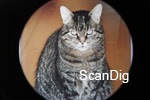
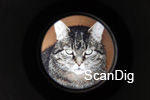
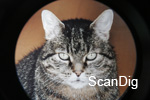
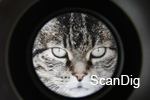
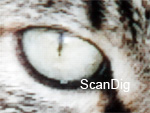
The adjoining figures show some examples for the illustration of the amplification of an amplifier that admittedly are non-binding due to the different distances of observation and the image circle diameter. A paper photo with a little cat is shown; the picture is enlarged by different amplifiers. On the last picture, there is a 1:1-cutout of the cat eye visible (Kaiser-precison magnifier 8-fold). The pixel structure of the digitally copied photography is visible, a thing that is not possible to see by the naked eye.
What is useful in any case for the observation of transparencies is a Light Panel. A further criterion is the design of the magnifier for the surface to be amplified. Sometimes, small magnifiers to not even offer an insight to the complete size of a small picture format (24 mm x 36 mm),others nearly cover the surface or do cover the surface completely of a standard medium format film (60 mm x 60 mm bzw. 60 mm x 70 mm).
Quality critera for magnifiers
Despite from the price, the magnifying factor and the possible magnifying surface, now the quality comes into play. But the quality primarily consists again on two factors, first the quality of manufacture and second, of course, the optical quality. While metal, plastic and optical glass are primarily applied in materials, in the optical quality, specially the disortion at the edge of contemplation as also the formation of a colour fringe are interesting.
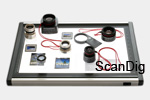
Furthermore, the total sharpness impression is absolutely to consider. In this concern, some (mostly rather first-class) magnifiers offer a sharpness configuration (Diopter compensation for ametropia) by an extendable eyeglass, others (rather cheaper ones) have to be put, similarly to the handling of an amplifier, to the right object and contemplation distance by holding them "in the air". Luxurious but really reasonable is the structure with an eyecup, that, similarly to the binoculars for wearer of glasses, can be striked down and/or upended. A thing that is a matter of course for photographers of large formats working at the focusing screen and employees of a graphic design agency working at the light panel during their daily work is a string that is very useful for the frequent change of the working place as for example from the computer screen to the light panel and further to the camera, as the magnifier that hangs from one's neck is always available.
Of course, the quality and the capacity of performance of a magnifier depends primarily on the materials used. It is evident that a magnifier with multi-layer coated aspherical lenses in a clean metal frame is higher-valued and more durable than a simple one consisting on two plastic pieces (lense and frame/holding). The use of aspherical lense surfaces provide a more uniform sharpness up to the edge of the image as also to a most widely free distortion with a better image field flattening (the contemplated surface really appears flat and not curved). The choice of different types of glass leads to the avoidance of colour fringes that can rather appear at the image edge/contemplation edge as in the middle. As also in the kitchen, the use of premium ingredients for a more complex recipe, most of the times leads to better results. Constructionally speaking, a multi-lensed system or a first-class lense is heavier and normally better as a simple "burning glass".
The structure influences, beside the size of the amplifier, the focal distance and design, also the visible field of view and the resulting distance of contemplation. In the end, an amplifier is designed, from the simple and cheap plastic magnifier uo to the high tech magnifier with a metal frame and/or in metallic optic, there is a lot available in the market. Anyhow, the optical qualities as also the appliance should primarily determine the purchase costs.
Basically, the photographical detail magnifiers should be always examinated with the help of a light desk. For a comparison, a normally printed paper of DIN A4 format (21x29,7mm) is absolute useful for the case there is no transparency material (slide/negative) available. Specially when such a printour is arranged with some text frames (90°- angle), either on the light desk as also by the reflected light contemplation, the quality differences can be absolutely recognized (distortion, image field flattening, formation of colour fringes). But it is always important to maintain the contemplating eye in the centre of the lense in order to be able to evaluate the quality from the centre up to the edge of the object.
In our shop there is a choice of photographic magnifiers of contemplation that I now would like to introduce and compare.
Kaiser Stand Magnifier 8-times
This small and simple magnifier is light (26 gram) and cheap. It does not offer any special features as a dioptre compensation or the possibility to fix a string. therefore, it has a relatively high factor of amplification of 8x, that is almost the same as the factor of models of a considerably higher quality. Of course, there is no optical top efficiency to expect within this price segment.
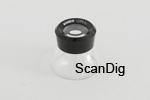
But it offers a sufficient sharpness to evaluate films and images providing they are contemplated form the centre of the magnifier. The sharp area covers approximately half of the size of a small image slide. But due to the simple structure there is, towards the edge of the image, a strong colour fringe as also an insufficient image field smoothing. The clear tube provides a good contemplation of non-transparencies, the diffusing light sensitivity during the contemplation of transparencies is behind the other failures. Anyhow, the casual user who needs from time to time a cheap but strong magnifier will be surely satisfied.
Kaiser Hand-Stand Magnifier magnoFlex 3,5-times
The speciality of this magnifier is the triple applicability. On one hand, when it is folded, it serves as a real microfilm reading glass that - as one is used with a "magnifying glass" - is simply hold in one's hand. In the other case, one makes use of the cleverly structured folding mechanism and in an instant, one has a stand magnifier for the vertical insight. By folding the supporting feet apart without the previous turn, the third possibility results: the angular insight is possible, a thing that is very useful on the desk for the quick magnificaton of anything.
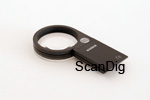
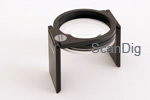
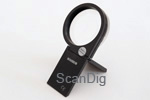
Due to the quite large diameter of the lense of 56 mm, this magnifier offers two advantages: first, the contemplation surface is quite large (a slide of a small image can be overseen at once) and second, it makes possible to have an absolutely high distance of contemplation. The relatively low amplification of 3,5x is a limiting factor. As this device is also rather low-priced, the optical quality in relation to the colour fringes towards the edge of the image as also the image field smoothing are not comparable to the devices that are significantly more expensive. The performance of sharpness is alright. The packaging contains a little pictured short instruction of use for the folding mechanism. the weight of the item is 68 gram.
Kaiser Precision Magnifier 4-times/8-times Metal Case
Kaiser Photo Technology offers beside its models for beginners also two significantly appearing magnifiers with metal case and a first-class lense in champaign. As both magnifiers practically do not differ of each other except in the structural size and the factor of amplification, they are both discussed here in one chapter. Within the price range for photo magnifiers they are located approximately in the medium-class, but their first-class appearance including a very good manufacture and a precise optical performance permit them to ascend to the upper class.
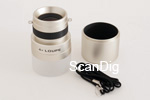
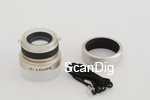
Already the weight makes the difference noticeable, the larger 4-fold magnifier weights - due to the "thinner" lense - incl. replacement tubes, 144 gram, the 8-fold magnifier weights in total 156 gram. Already the packaging is more posh; in the scope of delivery of both magnifiers there is either the matt transparent ring as also a metal ring (that correctly has a black layer in the inner side against diffusing light) as attachments. Additionally, there is a black string with circlips for fixing at the side eyes in order to hang the magnifier at one's neck. According to the construction, only in case of the 4-fold magnifier a cover is attached. This is very useful to protect the eyeglass against dust in case of non-use.
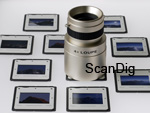
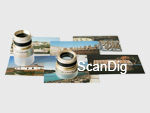
The valence of both magnifiers is emphasized in the test of amplification. The optical system are almost free from distortion and barely feature colour fringes. The 4-fold magnifier covers a small image slide in highly sharp quality, the 8-fold magnifier can cover in the high performance area of sharpness half of a small image. A field of curvature is not recognizable with the 4-fold magnifier, but in the case of the 8-fold magnifier, die to the considerable larger factor of magnification, it is. Both devices feature a well running swivel for the dioptric compensation. The appearance, manufacturing and the optical quality are totally given in these magnifiers, the price is absolutely suitable for their high quality. The short instructions that are not really neccessary are, unfortunately, only in English.
Rodenstock Aspherical Magnifier 4-fold
This magnifier from Rodenstock has a similar shape and size to the Kaiser Precision Magnifier 4-fold, but it promises an even better optical quality due to the appliance of aspherical lenses. But it only weights 73 gram because no metal piece is applied and therefore, it only consists on a high-class appearing plastic material and the glass lense. Contrary to the Kaiser 4-fold magnifier, it does have additionally a rubber eyecup that can be everted by the wearers of glasses. The dioptric compensation takes also place through a swivel at the eyeglass.
In this case, a red string is assembled at the factory, and the fixing solution is not so elegant, as it only hangs from one side. Contrary to the Kaiser solution, it does not have a changing tube but a slidable coverage that can be easily pushed upwards in order to release the matt transparent glass thereunder.

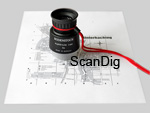
Here, a difference does come up: the glass surface of the diffusion disc is a considerable piece smaller than the one of the Kaiser Magnifier and therewith, the "image" in case of non-transparencies results considerably darker. The big surprise is provided by the enlarged image. It appears to be minimally richer in contrast as the one of the Kaiser 4-fold Magnifier, but a small image slide is not fully covered and although the aspherical lense there are slight colour fringes visible. There is no field of curvature to see, but a slight contortion at the edges. A clear instruction manual in German and English is attached. In total, the magnifier can be denominated as first-class quality, but due to the higher price it can not compete with the Kaiser 4-fold Magnifier.
Rodenstock Aspherical Magnifier 6x6 3-fold
The speciality of this magnifier is its size, because it was made for the contemplation of medium format slides and negatives. The name is very well known and in fact, the magnifier covers 60 mm x 60 mm. With its aspherical lense system it weights fully 200 gram and has, despite from the size, similar features to the aspherical 4-fold magnifier of Rodenstock: plastic case, eversible eyecups, a red string and a dioptric configuration through the turning eyeglass.
Only the change from transmitted light to indicent light works differently, here, there is a slide tube. The contemplation tube only consists on one piece: on one side it is matt transparent and on the other side it is black. Thus, the coverage is simply switched as per one's needs. Although the lense system provides here also a circle round picture, the image field is slightly barrel-shaped quadratically due to the structure and the design of the magnifier and the blind.
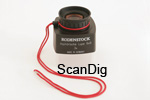
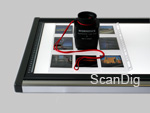
The slight magnification of 3x is enough for medium formats, but it also makes sure that no colour fringes are generated. There is no field of curvature recognizable, but therefore a surprisingly clear cushion-shaped distortion. The performance of sharpness is excellent. Due to the large transparency coverage, the non-transparent images appear to be brighter as with the "little sister" of Rodenstock. There was no instruction sheet attached to our test model.
In sumary, the magnifier of Rodenstock is typically well manufactured, the switchable blind is not an uninteresting alternative to the slide tube. The framed slides of small images do match completely under the magnifier, the medium format films are covered up to the format of barely 6 x 7. The magnification factor is not intoxicating, but enough for many appliances. The amazing downer remains to be the noticeable distotion at the edge of the image.
Rodenstock Aspherical Magnifier 6-fold
The most expensive magnifier of the test has a similar structure to both previous Rodenstock magnifiers, and/or a mixture of both, as it does have a round tube but the coverage is also switchable. As usual, it consists on plastic and has an aspherical lense system. Therefore, it offers a 6-fold magnification and does easily cover the format of a small image.
The diameter of the image field is approximately of 58 mm. With those values, it is also the heaviest representator of our magnifiers of this test. Included the two plastic covers for the eyeglass and the object side, the weight is of 226 gram. Everything else remains the same: red string, eversible rubber eyecup, dioptric compensation by a turning frame at the eye glass.
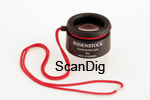
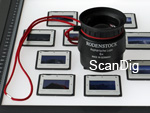
There is not much to critisize in the imaging performance and due to the switchable coverage, the non-transparency is represented brightly enough. The field of curvature that is understandable in this scale of enlargement is only slightly pronounced, the sharpness performance is very good. At the edge, there are very small colour fringes visible and the low distortion can be described as slightly cushion-shaped. In total, a not quite cheap but optically excellent and appealing universal magnifier for the application on small format images, but also for medium format photographers who require a larger scale of magnification. Also in this test model of the magnifier, there was no instruction attached.
Maintenance and Cleaning of Magnifiers
As it is the case in all other optical devices, also the magnifiers need a careful treatment. Already during the handling one has to be careful: in each lense system and each optical device there is a risk of breakage due to improper use as for example "to drop". It is a matter of course to treat them with special care. But this also includes the avoidance of fingerprints on the glass surfaces and to protect the magnifier against dust in case of non-use.
The dust coverages that are also delivered are, of course, the easiest help and the magnifiers without a provided dust protection are best kept in the original packaging or at least in the little bag that is provided in most of the cases. Nevertheless, beside the carefully handling and a dust-free storage, a cleaning is necessary from time to time. In case of gross dust, the best is to use compressed air (for example from a spray or a brush, from which different models partly have a bellow integrated).
Cords and finger prints are best removed with a special cleaning cloth, most of them offer - as also the optical cleaning paper - the possibility to use additionally special cleaning liquids. In our online shop you can also get complete cleaning sets for the maintenance and cleaning of your magnifiers.
Resume, conclusion
All magnifiers have one thing in common that is to show details by a certain amplification that are not recognizable by the naked eye. This works with all models tested. Depending on the requirement and the budget, the user will rather choose cheaper and therewith more simple models or models of a better quality and therewith more expensive ones.
Thus, the occasional user will be fully served with a low-budget model. What is to be mentioned positively here is the changeableness of the Kaiser Hand-Stand Magnifier (magnoFlex) 3,5-fold.On the other side, the purchase of a magnifier is also a purchase for a lifetime and specially the high-class Kaiser Precision Magnifiers (4-fold/8-fold) offer a lot of performance for a very resonable price. I mostly like the Kaiser 4-fold magnifier with which one gets optical maximum performance for a reasonable price, the Kaiser 8-fold magnifier actually unites the highest amplification factor of the test with an excellent shaprness and is good to handle.
All tested magnifiers of Rodenstock are very good, only the relatively high distortion of the 6x6 magnifier disgusts. Tee most expensive of all tested magnifiers, the aspherial magnifier 6-fold of Rodenstock is, with its image field size, the magnification factor and the all in all convincing quality of the of THE allrounder for small and medium format films as also for all non-transparencies.
Back to the index Hardware-Test Reports
|